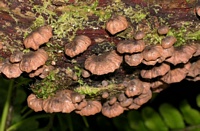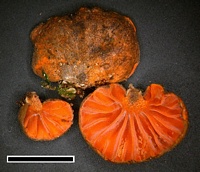|
 Anthracophyllum archeri Anthracophyllum archeri
SynonymsXerotus drummondii
Xerotus archeri
BiostatusPresent in region - Indigenous. Non endemic
Images (click to enlarge)
Caption: 1, Basidiomes x l; 2, basidia; 3, hyphoid cheilocystidia; 4, spores; 5, pileipellis elements; 6, stipitipellis elements (1, 3, 4 PDD 60843; 2 PDD 61127; 5, 6 PDD 60845). (Magnifications, see Fig. 1.) | 
Owner: J.A. Cooper | 
Owner: J.A. Cooper | 
Caption: scale=5mm
Owner: J.A. Cooper | |
Article: Segedin, B.P. (1994). Studies in the Agaricales of New Zealand: new records and new species of the genera Cheimonophyllum, Mniopetalum, and Anthracophyllum (Tricholomataceae, Collybieae). New Zealand Journal of Botany 32: 61-72 (http://www.rsnz.org/publish/abstracts.php).
Description: Basidiome 3-15 mm diam. when dried, small specimens sometimes excentrically stipitate, astipitate ones attached laterally to substratum. Pileus mid-brown with reddish patches to chocolate brown, drying very dark chocolate to almost black deeply, radially grooved, following the outline of the lamellae. Hymenophore bright brick red, reddish brown or deep orange, drying darker. Lamellae in up to three series, converging to a smooth, excentric point, the principal ones up to 9 in number, widely spaced, not interveined. One collection, on Metrosideros bartlettii J.W. Dawson, associated with a well-developed stroma, almost black on the outside when dry and hyaline internally, stroma often found cementing small branches of host together.
Spores 7.5-11 x 5-8 (9 x 6.2) µm, Q = 1.45, rather variable in size and shape, ovate to ellipsoidal, hyaline, with smooth walls and granular contents, contents becoming brownish or blue-green in KOH, inamyloid, not dextrinoid, acyanophilic. Basidia 2050 x 7-10 µm, clavate, 4-spored with conspicuous sterigmata-7 µm in length; basidioles common, like the basidia but 2.5-3 µm wide. Only a few basidia appear to mature at the same time. Cheilocystidia and pleurocystidia as usually recognised are absent but the basidia are frequently associated, both on the lamellar face and edge, with hyphoid cystidia about the same length as the basidia but narrower and with diverticulate branching towards the apex, arising at the base of the basidia or within the subhymenium (the pseudophyses of Singer & Gamundi 1963?). Trama of uniform interwoven to subparallel, hyaline, slightly thick-walled, glassy-looking hyphae, 3-6 µm diam., some with carbonaceous granules on their walls which become greenish blobs in KOH and eventually dissolve, making most of the trama and hymenium blue-green. Subhymenium of fairly closely interwoven hyphae like the trama but more closely septate and not sharply delimited from the trama. Context of similar, arrow, thickened hyphae, more branched and aboriform, but becoming thinner-walled near the pileipellis with green-staining incrustations. Pileipellis of repent hyphae giving rise to a turf of very narrow (1 -3 µm diam.) conspicuously clamped hyphae of Rameales structure, with green-staining granules, forming a network over the surface of the pileus. Stipe, when present, has similar but smaller diverticulate hyphae, some with noticeably thicker walls, arising from repent layer of slightly banded hyphae. Stroma when present also composed of narrow, thick-walled, sparsely branched hyphae. Near the surface, the hyphae are more branched and the surface bears small, erect, narrow, diverticulate hyphae with green-staining granules. All hyphae with clamp-connections, none gelatinised.
One collection (from Metrosideros bartlettii) had the hymenophore of many of the basidiomes eaten away by the larvae of a fly belonging to the Cecidomyidae. When the larval frass was squashed, ;he contents were found to be made up entirely of packets of hymenophore tissues of the fungus with the microscopic features intact. The larvae turned an unnatural greenish blue when preserved in KOH.
Habitat: Gregarious to caespitose on fallen twigs of various trees in indigenous forest.
Article: Massee, G.E. (1899) [1898]. The fungus flora of New Zealand. Transactions and Proceedings of the New Zealand Institute 31: 282–349 Wellington:.
Description: Gregarious. Pileus horizontal, laterally attached by a thickened stem-like point but sessile,
reniform, or almost circular, very thin, flexible when dry, glabrous or minutely cracked under
a lens, rust-colour or dark-red, almost even, margin often more or less lobed, the extreme
edge drooping and held down by the gills, about 1 cm. across; gills distant, radiating from the
persistently pale thickened point of attachment of the fungus to its support, rather distant,
broadest in front, not usually connected by veins, becoming blackish; spores dingy,
subglobose, 4-5 µ, diameter.
Habitat: On small twigs and branches.
Distribution: New Zealand. Australia.
Notes: In some of Drummond's specimens the pretty cockle-shell-shaped pilei are crowded on the
branches. There are fine specimens from New Zealand in Berkeley's herbarium. Disinguished
by the reddish pileus and very thin flexible flesh.
Article: Horak, E. (1971). A contribution towards the revision of the Agaricales (Fungi) from New Zealand. New Zealand Journal of Botany 9(3): 403-462 (http://www.rsnz.org/publish/abstracts.php).
Notes: The type of this species was originally found in Australia and is considered to be
synonymous with Anthracophyllum archeri (see Pegler 1965).
|